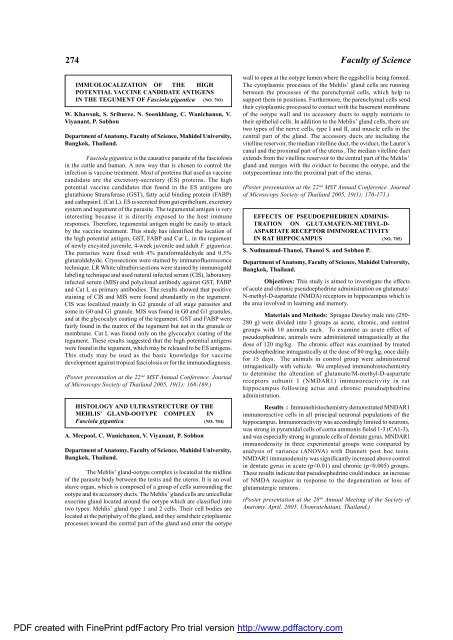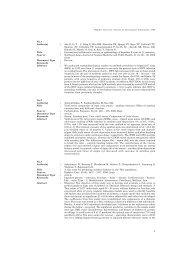Faculty of Science - Mahidol University
Faculty of Science - Mahidol University
Faculty of Science - Mahidol University
You also want an ePaper? Increase the reach of your titles
YUMPU automatically turns print PDFs into web optimized ePapers that Google loves.
274<br />
IMMUOLOCALIZATION OF THE HIGH<br />
POTENTIAL VACCINE CANDIDATE ANTIGENS<br />
IN THE TEGUMENT OF Fasciola gigantica (NO. 703)<br />
W. Khawsuk, S. Sriburee, N. Soonkhlang, C. Wanichanon, V.<br />
Viyanant, P. Sobhon<br />
Department <strong>of</strong> Anatomy, <strong>Faculty</strong> <strong>of</strong> <strong>Science</strong>, <strong>Mahidol</strong> <strong>University</strong>,<br />
Bangkok, Thailand.<br />
Fasciola gigantica is the causative parasite <strong>of</strong> the fasciolosis<br />
in the cattle and human. A new way that is chosen to control the<br />
infection is vaccine treatment. Most <strong>of</strong> proteins that used as vaccine<br />
candidate are the excretory-secretory (ES) proteins. The high<br />
potential vaccine candidates that found in the ES antigens are<br />
glutathione Stransferase (GST), fatty acid binding protein (FABP)<br />
and cathepsin L (Cat L). ES is secreted from gut epithelium, excretory<br />
system and tegument <strong>of</strong> the parasite. The tegumental antigen is very<br />
interesting because it is directly exposed to the host immune<br />
responses. Therefore, tegumental antigen might be easily to attack<br />
by the vaccine treatment. This study has identified the location <strong>of</strong><br />
the high potential antigen, GST, FABP and Cat L, in the tegument<br />
<strong>of</strong> newly excysted juvenile, 4-week juvenile and adult F. gigantica.<br />
The parasites were fixed with 4% paraformaldehyde and 0.5%<br />
glutaraldehyde. Cryosections were stained by immun<strong>of</strong>luorescence<br />
technique. LR White ultrathin sections were stained by immunogold<br />
labeling technique and used natural infected serum (CIS), laboratory<br />
infected serum (MIS) and polyclonal antibody against GST, FABP<br />
and Cat L as primary antibodies. The results showed that positive<br />
staining <strong>of</strong> CIS and MIS were found abundantly in the tegument.<br />
CIS was localized mainly in G2 granule <strong>of</strong> all stage parasites and<br />
some in G0 and G1 granule. MIS was found in G0 and G1 granules,<br />
and at the glycocalyx coating <strong>of</strong> the tegument. GST and FABP were<br />
fairly found in the matrix <strong>of</strong> the tegument but not in the granule or<br />
membrane. Cat L was found only on the glycocalyx coating <strong>of</strong> the<br />
tegument. These results suggested that the high potential antigens<br />
were found in the tegument, which may be released to be ES antigens.<br />
This study may be used as the basic knowledge for vaccine<br />
development against tropical fasciolosis or for the immunodiagnosis.<br />
(Poster presentation at the 22 nd MST Annual Conference. Journal<br />
<strong>of</strong> Microscopy Society <strong>of</strong> Thailand 2005, 19(1): 168-169.)<br />
HISTOLOGY AND ULTRASTRUCTURE OF THE<br />
MEHLIS’ GLAND-OOTYPE COMPLEX IN<br />
Fasciola gigantica (NO. 704)<br />
A. Meepool, C. Wanichanon, V. Viyanant, P. Sobhon<br />
Department <strong>of</strong> Anatomy, <strong>Faculty</strong> <strong>of</strong> <strong>Science</strong>, <strong>Mahidol</strong> <strong>University</strong>,<br />
Bangkok, Thailand.<br />
The Mehlis’ gland-ootype complex is located at the midline<br />
<strong>of</strong> the parasite body between the testis and the uterus. It is an oval<br />
shave organ, which is composed <strong>of</strong> a group <strong>of</strong> cells surrounding the<br />
ootype and its accessory ducts. The Mehlis’ gland cells are unicellular<br />
exocrine gland located around the ootype which are classified into<br />
two types: Mehlis’ gland type 1 and 2 cells. Their cell bodies are<br />
located at the periphery <strong>of</strong> the gland, and they send their cytoplasmic<br />
processes toward the central part <strong>of</strong> the gland and enter the ootype<br />
wall to open at the ootype lumen where the eggshell is being formed.<br />
The cytoplasmic processes <strong>of</strong> the Mehlis’ gland cells are running<br />
between the processes <strong>of</strong> the parenchymal cells, which help to<br />
support them in positions. Furthermore, the parenchymal cells send<br />
their cytoplasmic processed to contact with the basement membrane<br />
<strong>of</strong> the ootype wall and its accessory ducts to supply nutrients to<br />
their epithelial cells. In addition to the Mehlis’ gland cells, there are<br />
two types <strong>of</strong> the nerve cells, type I and II, and muscle cells in the<br />
central part <strong>of</strong> the gland. The accessory ducts are including the<br />
vitelline reservoir, the median vitelline duct, the oviduct, the Laurer’s<br />
canal and the proximal part <strong>of</strong> the uterus. The median vitelline duct<br />
extends from the vitelline reservoir to the central part <strong>of</strong> the Mehlis’<br />
gland and merges with the oviduct to become the ootype, and the<br />
ootypecontinue into the proximal part <strong>of</strong> the uterus.<br />
(Poster presentation at the 22 nd MST Annual Conference. Journal<br />
<strong>of</strong> Microscopy Society <strong>of</strong> Thailand 2005, 19(1): 170-171.)<br />
EFFECTS OF PSEUDOEPHEDRIEN ADMINIS-<br />
TRATION ON GLUTAMATE/N-METHYL-D-<br />
ASPARTATE RECEPTOR IMMNOREACTIVITY<br />
IN RAT HIPPOCAMPUS (NO. 705)<br />
S. Nudmamud-Thanoi, Thanoi S. and Sobhon P.<br />
<strong>Faculty</strong> <strong>of</strong> <strong>Science</strong><br />
Department <strong>of</strong> Anatomy, <strong>Faculty</strong> <strong>of</strong> <strong>Science</strong>, <strong>Mahidol</strong> <strong>University</strong>,<br />
Bangkok, Thailand.<br />
Objectives: This study is aimed to investigate the effects<br />
<strong>of</strong> acute and chronic pseudoephedrine administration on glutamate/<br />
N-methyl-D-aspartate (NMDA) receptors in hippocampus which is<br />
the area involved in learning and memory.<br />
Materials and Methods: Sprague Dawley male rats (250-<br />
280 g) were divided into 3 groups as acute, chronic, and control<br />
groups with 10 animals each. To examine as acute effect <strong>of</strong><br />
pseudoephedrine, animals were administered intragastically at the<br />
dose <strong>of</strong> 120 mg/kg. The chronic effect was examined by treated<br />
pseudoephedrine intragastically at the dose <strong>of</strong> 80 mg/kg, once daily<br />
for 15 days. The animals in control group were administered<br />
intragastically with vehicle. We employed immunohistochemistry<br />
to determine the alteration <strong>of</strong> glutamate/M-methyl-D-aspartate<br />
receptors subunit 1 (NMDAR1) immunoreactivity in rat<br />
hippocampus following actue and chronic pseudoephedrine<br />
administration.<br />
Results : Immunohistochemistry demonstrated MNDAR1<br />
immunoreactive cells in all principal neuronal populations <strong>of</strong> the<br />
hippocampus. Immunoreactivity was accordingly limited to neurons,<br />
was strong in pyramidal cells <strong>of</strong> cornu ammonis fielsd 1-3 (CA1-3),<br />
and was especially strong in granule cells <strong>of</strong> dentate gyrus. MNDAR1<br />
immunodensity in three experimental groups were compared by<br />
analysis <strong>of</strong> variance (ANOVA) with Dunnett post hoc tests.<br />
NMDAR1 immunodensity was significantly increased above control<br />
in dentate gyrus in acute (p
















